How to Wipe a Hard Drive on Any Operating System in 2025: Garbage Disposal
These days, it’s hard not to think about your data’s safety. If you’ve ever disposed of or sold an old computer, you might already know the anxiety of putting something with your information on it into the hands of another person. To help you keep your data private, we’re looking at how to wipe a hard drive completely so it’s ready for disposal or sale.
If you’ve ever sold or disposed of an old computer, the thought probably crossed your mind that your data on that drive could still be vulnerable, and you’d be correct. Depending on how you cleared the drive, there could be huge amounts of recoverable data left behind. That’s why in this article we’re going to look at how to wipe a hard drive.
Key Takeaways:
- To protect your information, you should always wipe your hard drive before disposing of it or selling it.
- It’s important to make a backup before you wipe your drives because after the process is complete, the files will be irrecoverable.
- There are several options for how to wipe your hard drive, including using your operating system’s built-in method as well as third-party drive wiping software.
- No matter how you choose to wipe your drives, make sure the chosen method will perform at least one zero-pass to truly wipe all data from the drives.
These days, every major operating system has some baked-in way of formatting drives, but you have to be sure to select the correct options in order for your drives to be truly wiped clean. Keep reading to learn the differences between formatting, wiping and deleting, as well as the best methods for clearing your drive.
-
09/01/2021
Updated and expanded instructions. Replaced images.
How to Wipe a Hard Drive for Recycling or Reuse
We’re going to look at two options for wiping your hard drives. The first method is the one baked into each operating system. We’ll look at Windows 10’s recovery formatting, MacOS’s disk utility and the command lines you’ll need to wipe a drive using Linux.
Then we’ll look at another option to wipe your drive: third-party software. For most applications, the built-in drive wiping options that come with most operating systems is strong enough to protect your data.
However, if you are disposing of a hard drive that has valuable and sensitive information on it and want more robust security measures, then third-party software can offer those kinds of features.
It is usually a good idea to backup your data before starting this process, since once it is complete your data will be irrecoverable. You can do this with a physical backup to an external hard drive or with a cloud backup service.
Reasons Why You Might Want to Wipe a Hard Disk Drive
Any time you dispose of an old hard drive or sell a computer, you should absolutely make sure that your data is wiped from the drives. It’s not difficult to recover the information on hard drives that have been improperly disposed of, allowing access to personal information such as saved passwords or banking information.
Deleting Files vs Wiping or Erasing a Hard Drive
When you delete a file on your computer, the system does very little to that data. In short, all it really does is earmark that space as no longer being occupied. The files themselves are essentially left intact until they are overwritten by something new.
“Formatting” is the term used for the process of getting a fresh drive ready for use or an old drive ready for a new life, but it’s also involved in the process of wiping a drive. Think of formatting as laying down the infrastructure of the hard drive so that the operating system has a way of quickly cataloging and identifying the stored information.
Wiping a hard drive is often included as an optional step in the process of formatting. A quick format skips this step and simply recognizes the drive as empty — much like deleting a file does — without overwriting the data on the drive.
Unfortunately, quick format is the default option for most operating systems, meaning that many people unknowingly dispose of drives that have not been properly wiped.
There are many methods of wiping a hard drive, but the most common is called a “zero-pass.” This means that the hard drive overwrites the entire storage volume with zeros and truly gets rid of the data that was there.
Depending on the size and write speed of your drive, this process can take many hours, since the drive has to write potentially terabytes of zeros. For this reason, it’s best to set up the process to run overnight if you can.
How to Wipe a Windows Computer Hard Drive in 5 Steps
- Open the “Update and Security” Page in Windows
The built-in method for wiping a drive in Windows is, somewhat surprisingly, found in the update and security page of the settings. Go into the Windows settings and head to the “update and security” page.
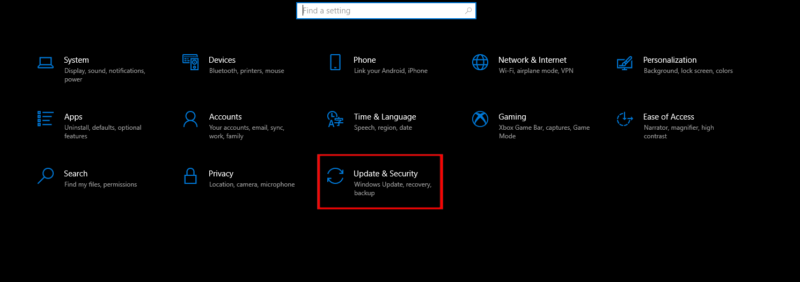
- Start the Recovery Process to Format and Wipe the Drive
Select the “recovery” tab, and under the “reset this PC” option, click “get started.” Once your hard drive is formatted and wiped the data will be irrecoverable, so make sure to make backups of anything you even might end up wanting back.
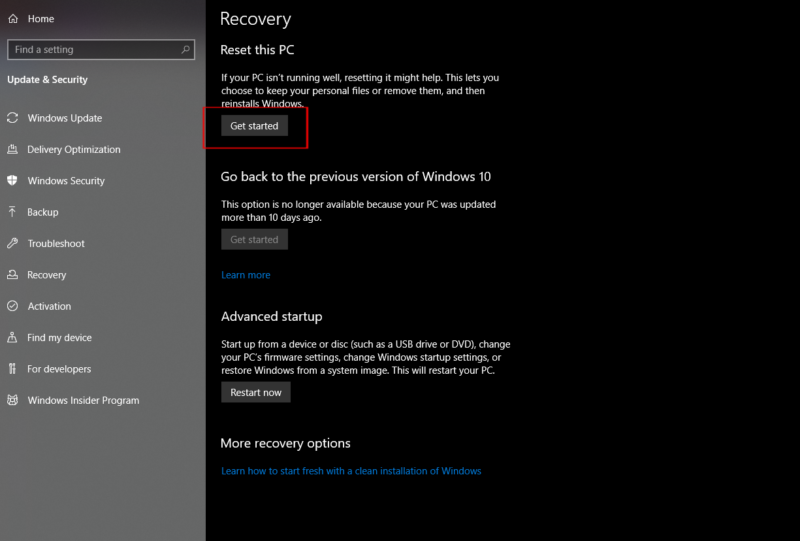
- Select the Option to Remove Everything During the Format Process
Here you can choose whether you simply want to reformat your hard drive but keep your files, or remove everything and wipe the drive completely. To wipe your drive, choose the option to remove everything.
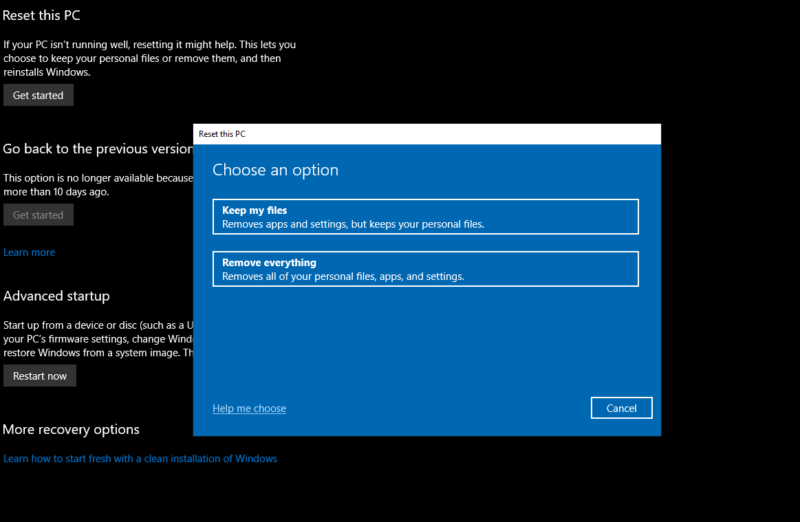
- Select Local or Cloud Windows Installation
You’ll then be given the option to use the local Windows installation files or download a fresh copy of Windows 10. This is up to personal preference and doesn’t affect the quality of the drive wipe.
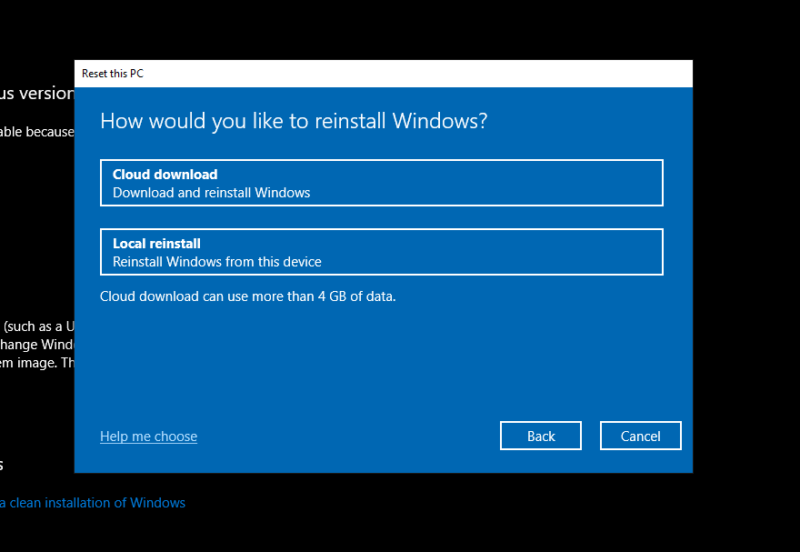
- Make Sure You Set It to Clean the Data From Your Drive
Once you choose your operating system, you’ll have the chance to review your selections. If you want to actually wipe your drives rather than just format them, change the settings to “clean data,” which is off by default. Finally, click “confirm” to enable zero-pass and allow the formatting process to begin. Windows is not set up to wipe your hard drive by default, so make sure you toggle the clean data option in the settings.
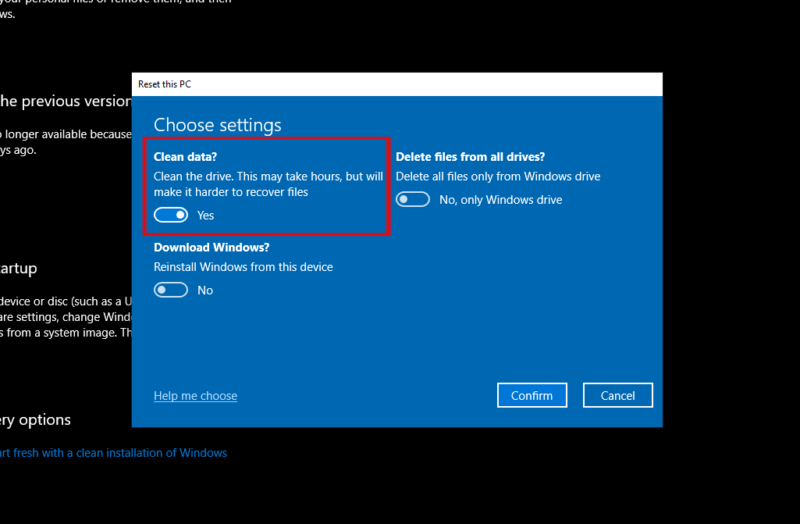
How to Wipe a Mac Computer Hard Drive in 5 Steps
- Launch the Mac Disk Utility
Open up Spotlight by pressing the command key and space bar. Type in “disk utility” and launch the application. The Mac disk utility shows an overview of your drives such as how much free storage is left and how it’s currently formatted.
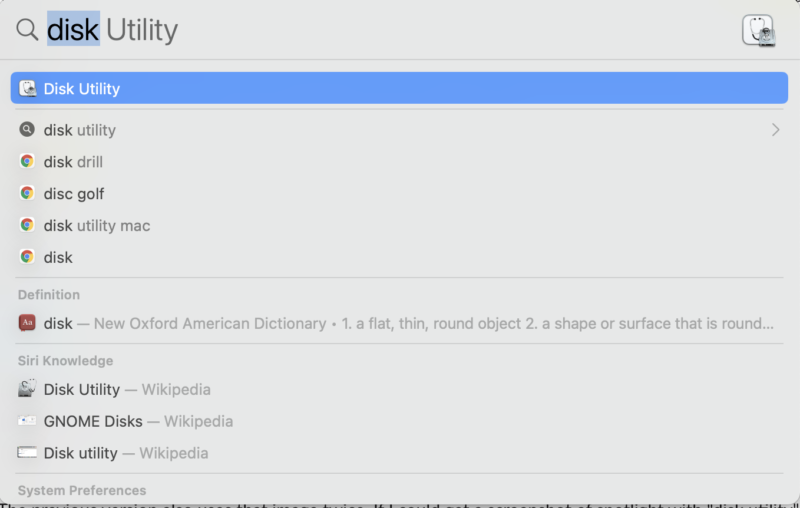
- Begin the Drive Wiping Process
To wipe a drive in disk utility, select the drive you want to wipe and click the “erase” button at the top of the screen.
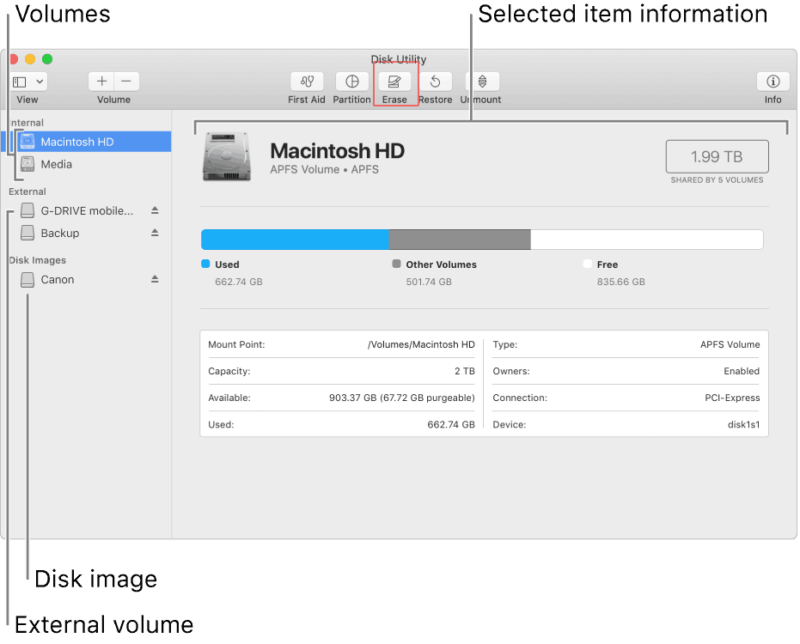
- Select How the Drive Will Be Formatted
A window will open up prompting you to choose a name and formatting method for the drive. Apple’s default disk format is called APFS, but if you plan to use both Windows and Apple on the device — or want to keep your options open — select exFAT formatting instead.
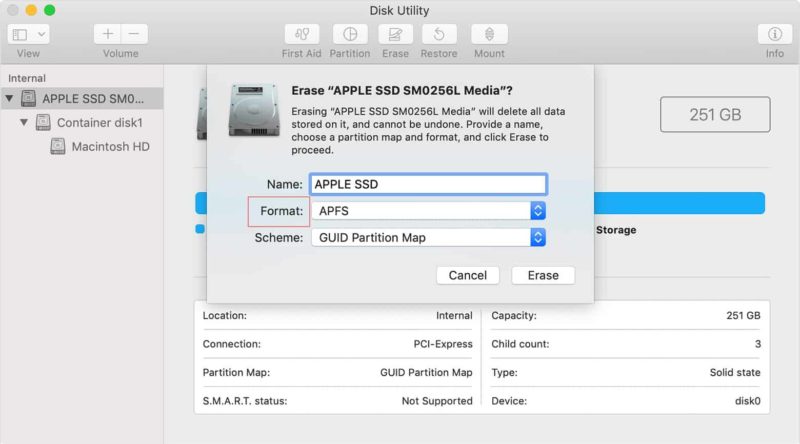
- Choose What Kind of Method Will Be Used to Wipe the Drive
Select “security options” to choose how thoroughly the disk is wiped. The fastest method is a quick format, which won’t entirely erase your data. The intermediate option performs a zero-pass to wipe data cleanly from the drive, while the most secure option will perform seven zero-passes; this meets the US DOD standard for wiping a drive. The most secure options can take many hours to complete due to the number of passes it makes on the drive.
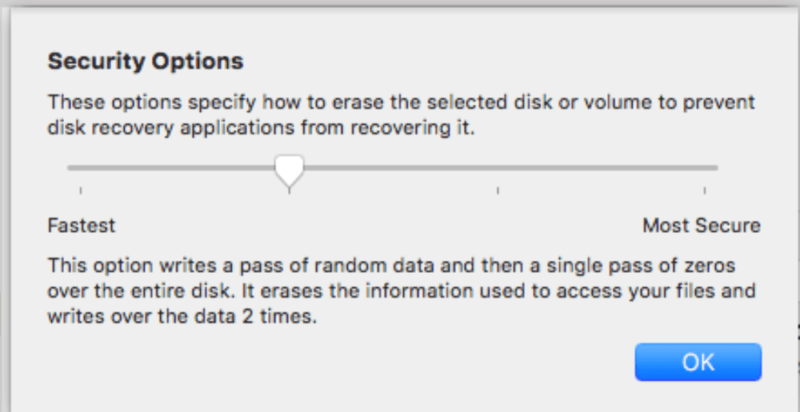
- Finalize the Process and Let It Rund
Finally, click the “erase” button and wait for the drives to finish formatting. This can take several hours, especially if you opt for multiple zero-passes. Also make sure any files you potentially want to keep are backed up somewhere before starting the formatting and wiping process.
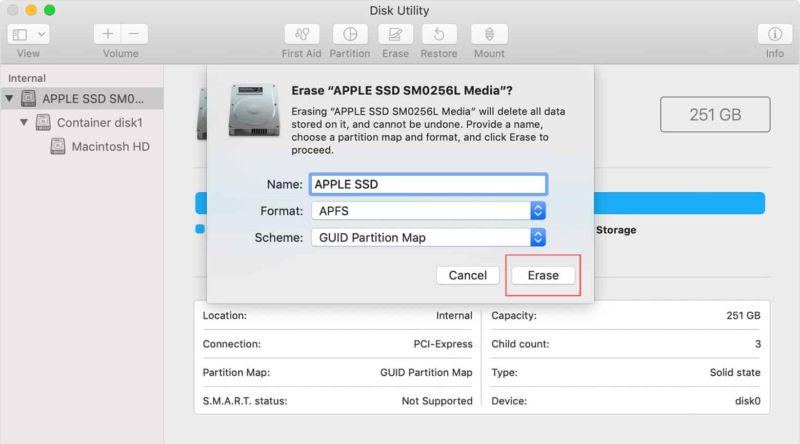
How to Wipe Your Hard Drive in Linux
Linux, as its users already know, is a bit different from other operating systems. Each Linux build may have slightly different means of wiping hard drives, but almost every Linux distro will have a few options available for erasing a drive.
DD Command
The first command line option is the dd command, which comes in two forms. The first option performs a zero-pass, while the second option uses random ones and zeros. This is more secure, but also more time consuming. In our example command lines below, “X” needs to be replaced with the target drive letter.
- dd if=/dev/zero of=/dev/sdX bs=1M
- dd if=/dev/urandom of=/dev/sdX bs=1M
Shred Command
The other drive clearing method that most Linux systems have built in is the shred command, which performs multiple passes of random ones and zeros to wipe your drive. If you use the first example command, it will perform the default three passes.
To specify a custom number of passes, simply replace the “Y” in the second example with the desired number. As with the dd command , the “X” in this example will be replaced by the target drive letter.
- shred -vf /dev/sdX
- shred -n Y -vf /dev/sdX
Third-Party Drive Wipe Options
If you want more control over the drive wipe process or want to wipe a hard disk drive outside of any operating system, there are plenty of options. Many robust third-party software options exist, with one popular option being DBAN.
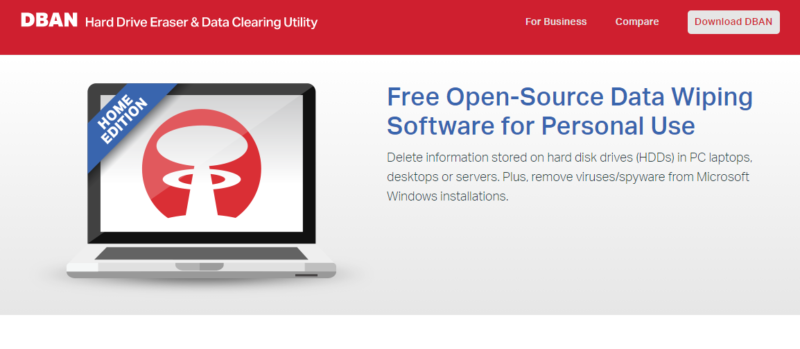
DBAN is an open-source software that you can download for free. In order to use DBAN, you have to mount it to a USB or disk and boot your computer from that, which can be done in the BIOS. Drive wipe software can be a bit more challenging to use if you’re unaccustomed to working in BIOS, but it allows you to wipe a drive without using an operating system at all.
Additionally, DBAN and other third-party software provide some wipe options that operating systems don’t — such as PRNG and RCMP — which both offer unique advantages over run-of-the-mill zero-passes.
PRNG wipes the drive using random data, while RCMP writes several passes of ones followed by several passes of zeros, with a random data pass at the end for good measure.
Final Thoughts
It is critically important when getting rid of old hardware to make sure all the information is truly gone before you hand it off to someone else or send it to the trash bin. Luckily, most operating systems now have a built-in way to do that, which makes it easy to wipe a hard disk drive completely clean.
We also have a guide on how to clear disk space with cloud storage.
Have you ever sold or thrown away a computer with the hard drive still in it? Did you wipe the hard drive completely first or just toss it out? Let us know in the comments below and, as always, thanks for reading.
FAQ
Wiping a hard drive with a zero-pass or other methods completely destroys the data. This means that in almost all cases, it is impossible to recover.
Hard drives can be wiped using tools included with most operating systems or by using third-party software. Regardless of which method you use, you’ll need to let the drive complete a zero-pass to completely overwrite the data before it is safe to sell.
Completely erasing a hard drive can be done in the operating system or with third-party tools. Either way, you must allow the drive to perform at least one zero-pass. This can take some time, but ensures the data on the drive is completely erased.
Yes, formatting a drive can be done easily in most operating systems and the computer will set itself back to factory standard if instructed to do so. Windows even allows you to choose whether the OS is coming from the existing installation or a new download.

